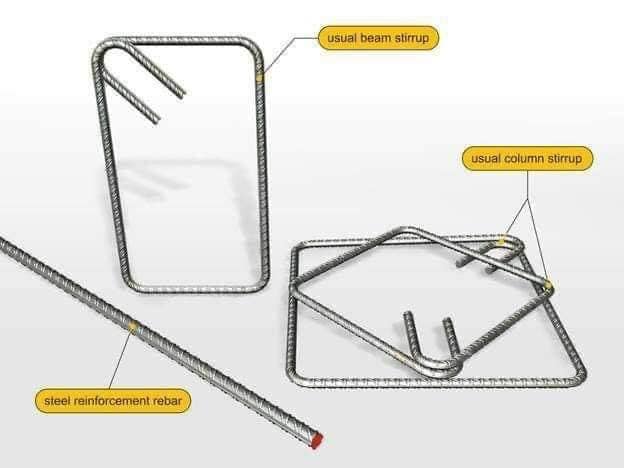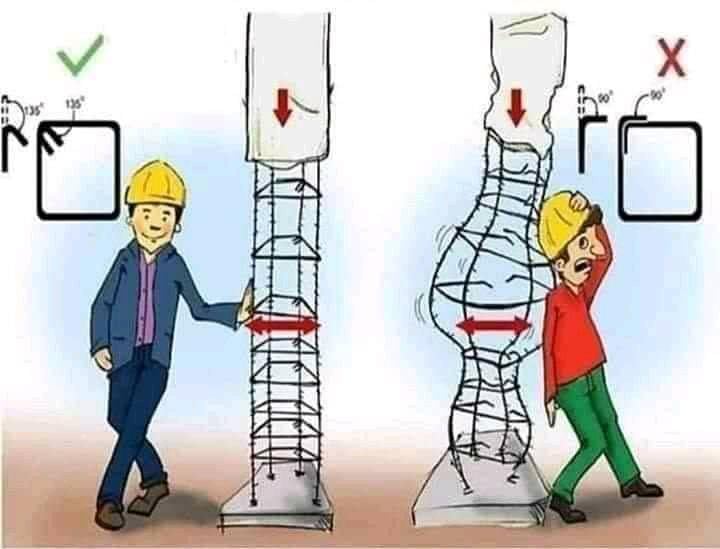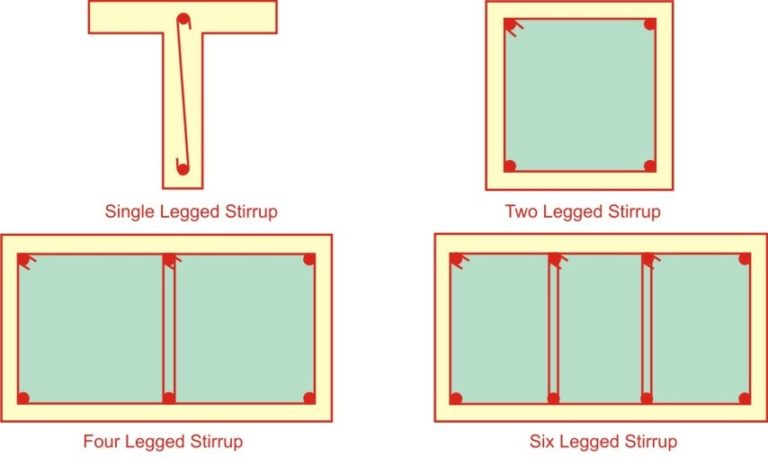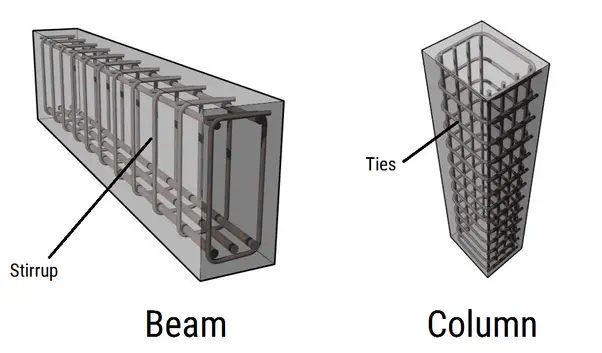Stirrups Rebar in Construction | Types of Stirrups | Difference Between Lateral Ties and Stirrups
Stirrups Rebar | Stirrups Concrete| Stirrups in Column | Stirrups in Constructions
What Is a Stirrup in Rebar?
Stirrups are rectangular steel elements that are utilized in RCC structures to counteract lateral shear and diagonal tension stresses. They used to secure the primary reinforcement rebars in an RCC construction.
Stirrups aid in the retention of primary reinforcement bars and prevent columns from buckling. They are used to secure beams and columns at the right intervals to prevent them from buckling. Additionally, they prevent RCC constructions from collapsing as a result of seismic activity (earthquakes).
Stirrups in Constructions
In concrete construction, a stirrup is used to secure the primary longitudinal rebar in concrete beams or columns. They are typically square or rectangular in shape and comprise five 90° bends. The bends at the bar’s ends overlap.
Stirrups are typically constructed from a rectangular steel component wrapped over the top and bottom bars of the beams. Stirrups serve in the retention of the principal reinforcing bars. Stirrups are required to keep the columns and beams from buckling.
Stirrups are usually arranged diagonally and vertically. This is done to avoid shear failure, which is generally diagonal in nature when beams develop cracks. The diagonal shear is mostly induced by compression and tension caused by transverse and vertical tension.
Diagonal tension eventually emerges due to the fact that concrete is stronger in compression than in tension. This tension is held in check by a steel stirrup that secures the broken surface.
The stirrup spacing along the beam is critical and should be specified by the designer. This will aid in the construction of the stirrups. They are typically placed in areas prone to shearing, such as beneath heavy loads and bearing points.
Concrete is strengthened by passing steel bars through it. Stirrups, on the other hand, are employed to keep things in order.
Stirrups help maintain order and also reinforce the structure at important locations where it may become vulnerable over time due to use.
Stirrups are not as sturdy as steel rebars. However, stirrups are frequently used in conjunction with rebar.
While the rebar serves as the concrete’s backbone, the stirrups assist the rebar in remaining straight and providing additional support to the column of concrete in which it is inserted.
Stirrups contribute to the establishment of much-needed resistance. When pressure from above is applied to the column, the stirrups function similarly to tendons. They assist the rebar and concrete in providing long-term support for the severe stress.
What Is the Purpose of Rebar Stirrups?
Stirrups are used to secure the primary reinforcement rebar in an RCC construction. Stirrups are used to secure beams and columns at the right intervals to prevent them from buckling.
Types of Stirrups
Stirrups of the following types are frequently used in reinforcement, and in certain instances, the designer alters the stirrups to meet the design requirement.
- Single Legged Stirrups (Open Stirrup)
- Two-Legged or Double legged Stirrups (Closed)
- Four-Legged Stirrups (Closed)
- Six-Legged Stirrups (Closed)
- Helical Stirrups (Open Stirrup)
- Circular Stirrups (Open Stirrup)
Single Legged Stirrups
While single-legged stirrups are not frequently used, they can be advantageous when just two rods need to be bound. Rather than a complete loop, these single-legged stirrups resemble a flattened U-shape.
Two-Legged or Double
Stirrups with two legs or with four legs are some of the most frequently used stirrup variants in the business. This stirrup requires a minimum of four rods to construct.
Four-Legged Stirrups
The four-legged stirrup is the next step up, and it typically comprises of two overlapping stirrups that do not completely surround the rods. For instance, if you have eight rods in two rows of four, the two overlapping stirrups will encircle six rods each, with the four in the center wrapped in both.
Six-Legged Stirrups
You can also use a six-legged stirrup to support the same eight-rod configuration. A single stirrup envelops all eight rods in this design, and additional legs provide additional support. Typically, these additional legs extend between two adjacent rods.
Circular Stirrups
Though the stirrup options previously discussed are appropriate for square or rectangular projects, columns require a circular stirrup. The actual dimensions of the stirrup will vary according to the size of the project and the number of rods requiring reinforcement.
Helical Stirrups
Helical stirrups are so named due to their similarity to a double helix of DNA. Rather than encircling the rods in a complete circle, a helical stirrup resembles a spring, adding additional support to predominantly circular columns.
Lateral Ties
If stirrups are insufficient to meet your project’s requirements, lateral ties can be added. While these bars will not form a complete loop like stirrups, they can nonetheless provide additional support.
Why Stirrups are Important
Stirrups are used both horizontally and vertically in columns and beams. Stirrups are used to secure the primary rebars in an RCC structure.
Stirrups are employed in columns to prevent the main reinforcement from buckling. Stirrups prevent diagonal cracking in beams caused by shear, which is why we give them as shear reinforcement.
- It increases the column’s compressive strength.
- It can increase the column’s ductility.
- Stirrups prevent the column’s main reinforcement from buckling.
- During the concrete pouring process, it prevents the primary reinforcement from moving.
- Enhance the column reinforcement’s dowel action.
- In beam stirrups, the same purpose as in column, are employed for lump sum calculations.
- To install longitudinal bars with lateral confinement
- It resists shear and torsion.
- For the purpose of securing longitudinal bars during construction
- Its core confines the concrete, increasing its ductility and strength.
- It prevents individual bars from buckling prematurely.
- To mitigate the effects of torsional and shear forces.
- To mitigate the effects of wind and earthquake forces.
What is the Maximum Size of a Reinforcement Diameter Used for Stirrups?
Diameter of bar used for Vertical Stirrups (Shear Reinforcement)
Minimum size of stirrups steel bars 6mm (1/4″) and Maximum size is 16mm (5/8″)
What Is the Difference Between Lateral Ties and Stirrups?
lateral ties are used in columns The ties are and are uniformly spaced throughout the column’s height. The vertical steel bars support the load, while the ties secure the bars in place during compacting the concrete with the needle vibrators.
The ties do not hold or share any of the load that is applied to the column.
Stirrups refer to the transverse reinforcement utilized in beams when bending and shear are the predominant modes of load transfer.
Stirrups are used to prevent cracks in the concrete beam from forming as a result of stress, bending, and shear. The stirrup spacing varies along the length of the beam. They are more closely spaced near the supports and more widely scattered in the central section.
Stirrups are used for shear and torsional reinforcement and come in a variety of configurations. In a large beam, you may have four stirrups set at 4-6″ apart, or a single stirrup.
Ties are frequently used in compression members such as columns and can be spaced apart or spiraled continuously. They are always wrapped around the longitudinal reinforcement, preventing the compression member from “blowing out” under extremely high loads. They can also be utilized as stirrups for shear and torsional reinforcement.
The essential difference between stirrups and lateral ties is that the former are used to resist shear stress, whereas the latter are used to simply connect the primary reinforcing parts. Stirrups are utilized in beams, whereas ties are used in columns.
To resist shear, both lateral ties and stirrups are used. For columns, lateral ties are used; for beams, stirrups are used.




